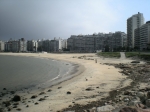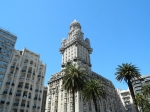Information about Montevideo
Montevideo is the capital of Uruguay is located on the banks of the Río de la Plata, 34, 5 degrees South Latitude and 56 degrees West Longitude.
It has an area of 530 square kilometers (approximately 60 is rural area and the remaining 40 urbanized or potentially urbanizable area) and a population of 1,330,405 inhabitants.
It limits to the west with the department of San José, and to the north and east with that of Canelones. To the south it has coasts on the Río de la Plata, where the bay of Montevideo and the main port of the region are located.
It is divided into 8 municipalities
The first settlers of the city were families of Spanish origin, arriving from Buenos Aires, a colonial center in this region of the continent. The foreground and standard of the city (work of Pedro Millán) dates from 1726, when it was called "San Felipe and Santiago de Montevideo". At that time the first settlers began arriving from the Canary Islands. During the colonial era, the condition of Montevideo as the main port of the Río de la Plata generated several clashes with Buenos Aires, the capital of the Viceroyalty.
The Citadel of Montevideo was built over 40 years. Like many other colonial cities in America, it had a Plaza de Armas in the center, in front of the Church and the government building (the current Plaza Matriz, the Cathedral and the Cabildo). The city was surrounded by thick walls with a large entrance portal, of which the emblematic Citadel Gate on the Plaza Independencia is witness.
The English Invasions of 1807 marked the history of the city, liberated by oriental troops that same year. His consideration of "Very Faithful and Reconquering" was maintained during the May Revolutions of 1810 (in Buenos Aires), when the city remained faithful to the Spanish crown, which installed its headquarters there. It was a time of growth for the still small city.





